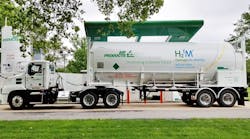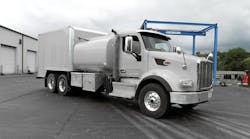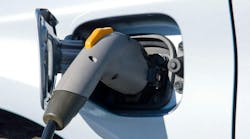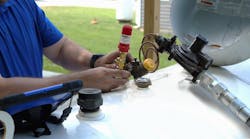THE Clean Air Act emissions requirements of 2006 and ultra-low-sulfur diesel (USLD) have combined to create The Perfect Storm, with corrosion being one of the unintended results.
In “Corrosion in the US Ultra-Low-Sulfur Diesel Distribution System and Implications for Terminal Operations,” Andrew McKnight, technology platform director for Innospec Inc, said the 15 ppm sulfur ULSD required for new, improved diesel engines and other changed fuel properties have resulted in corrosion and biological contamination.
“It’s something that’s not going away, and something we’re going to see more and more of,” he said during the Independent Liquid Terminals Association’s 2013 International Operating Conference. ”This is not a problem that’s localized to one particular type of operation in a distribution system.”
He said the sulfur reduction from 500 to 15 ppm is a negative development because sulfur is antagonistic to microbial growth. The changes in ULSD mean fewer aromatic and phenolic compounds, which are good growth inhibitors; an increase in saturates, which are the preferred food source compared to aromatics; and an increase in free water (non-dissolved), which increases microbial growth.
McKnight said corrosion affects manufacturing through the end user. Some refinery and terminal tankage is affected, and the problem worsens farther downstream. The biggest effect is on retail/commercial underground storage tanks and dispensing systems. There is sporadic, inconsistent occurrence geographically.
He said Ford Motor Co reported corroded/delaminated pickup fuel tanks in 2010, and was the first to propose that acetic acid may be the cause.
Diesel corrosion page 2...
“We’re working with one major diesel-engine OEM that says most of their failed injectors are corroded,” he said. “GM (General Motors) has seen corroded injectors/injection systems in light-duty diesel engines on pickups and medium-duty trucks.”
According to a three-year study of excessive corrosion in end-user underground fiberglass storage tanks (USTs) that produced the Batelle Report, the corrosion was predominantly caused by a biological source, and microbial activity major was the cause of extensive corrosion problems.
“Low molecular weight acids—acetic, etc—were produced from ethanol-eating bugs,” he said. “Traces of ethanol were found in samples. Ethanol probably comes from switch-loading transport trucks. A proposed Phase II study will look upstream of retail to refineries, terminals, etc.”
What can happen in a fuel storage tank?
“Microbes cannot grow in fuel alone,” he said. “It’s not the right environment for them. Water is required for microbial life, growth, and reproduction. Microbes, in general, live at the fuel-water interface—water bottoms and any place a droplet of water is present.”
He listed the potential impacts of microbial growth: consume fuel; generate acids, and acids generally are corrosive, with anything above a pH of 8 tending to corrode steel; make sludge and debris; generate surfactants and emulsions; promote corrosion; and clog filters and burner nozzles.
Innospec has been studying the problem for several years by belonging to the CDFA Task Force (Battelle Report), testing internal companies’ key fuel/water properties, and working with several refining and/or marketer customers.
McKnight said they have found low molecular weight acids (eg acetic, etc) in fuel/water bottoms, including refinery and terminal tanks (no ethanol).
“Low MW acids and positive bug tests go hand-in-hand,” he said. “Most positive tanks have low pH.”
McKnight showed a picture of a pump top from a submersible tank that had previously held E10 gasoline. There was corrosion on the top and other external parts.
Diesel corrosion page 3...
“The effect is similar to ULSD corrosion: E10 vapors escape to a sump well and become a food source for ETOH-eating bugs, which create acetic acid, which in turn causes the corrosion,” he said.
He also showed a separated submersible tank pump from a major chain retail station in the Houston area. The pump was only four years old, but the riser threads were eaten away and the discharge riser was corroded.
“For anybody trying to throughput fuel in the retail site, not only is it slow-flowing, but in extreme cases stopped,” he said. “That’s lot of dollars for a retail station.”
He showed examples of corrosion on dispensing equipment: a diesel dispenser screen, retail diesel dispenser filter adaptor; and diesel dispenser filter (inside surfaces).
“We’re getting involved a lot more in working to get more information on terminal tanks,” he said. “Obviously for those who are protecting assets like these, catastrophic failure of the internals of a tank will be a big problem. A tank collapse due to corrosion … this is something that can happen and has happened.”
He said storage tank floors, overhead spaces, and structural welds have high microbial activity and acetic acid and low pH.
“The problems we saw in retail, we’re starting to see in terminal operations,” he said.
McKnight said recent information indicates that vehicle fuel-injection system equipment is being damaged by corrosive ULSD. “We’re getting more and more work from our OEM partners with corrosion,” he said.
Corrosion is damaging high-pressure pump housing, throttle plates, needles, and guide bodies.
Diesel corrosion page 4...
If it’s not microbial corrosion, there are alternate possibilities:
• Corrosion inhibitor depletion theory (aka “diesel soap theory”). Oxidized diesel, acidic additives, etc, form soaps if contacted with excessive tank water sodium from salts or caustic. Tank water from manufacturing processes—caustic/salt upsets, biodiesel—provides a sodium and/or calcium source.
• Corrosion protection is lessened. The effect is similar to soaps formed from acidic lubricity improvers—mono acids, etc—and sodium/calcium.
• Lubricity is lessened.
He said soap formation comes through oxidized hydrocarbon fuel, acidic corrosion inhibitors, and acidic lubricity improvers, and can also come through NaCl salt and high shear.
“Fuel soaps can lead to vehicle engine deposits,” he said. “Fuel ‘soaps’ and salts can be found in plugged diesel dispenser filters, vehicle filters, and engine fuel injectors. Much study has been done in the area of injector deposits through the Society of Automotive Engineers and Coordinating Research Council. Injector deposits, either from fuel soaps, corrosion or degraded fuel, can cause serious problems in engines—especially in newer High Pressure Common Rail (HPCR) systems where metal-metal clearances are very tight (2 um).”
He said Innospec’s downstream NACE (National Association of Corrosion Engineers) corrosion testing shows a majority of retail ULSD is non-passing for NACE corrosion (“B” or worse).
“We’ve seen that a NACE corrosion rating usually degrades as fuel moves through the distribution system—this is normal—and the inhibitor tends to attach to metal surfaces for protection. It may mean that fuel needs better additive optimization at the refinery. It also may mean that a secondary infusion of corrosion inhibitor may be required at the terminal.
“Some engine manufacturers are calling for a NACE specification on existing fuel specs. There are currently none in ASTM D 975. It should be interesting to see how far that goes. More study is needed.”
He said Innospec’s customer storage tank samples from across the United States since January 2011 show very high concentrations of sodium and other components (Ca, K, Zn, etc.) found in both fuel and tank water bottoms.
“It has implications for both distribution systems and vehicle fuel injection systems,” he said. “Bosch/Cummins and others say even 0.1 ppm sodium in fuel can be problematic.
Diesel corrosion page 5...
“Proper housekeeping is the key. Water is fuel’s enemy, so regular removal of tank water bottoms and contaminants goes a long way. Routing monitoring for biological contamination is important. Using the proper biocide at the correct dosage and contact time if needed also helps to control the problem. Routine testing of downstream ULSD for corrosion will help ‘fix’ the problem.
“Use of synthetic, non-acid, and non-reacting corrosion inhibitors and lubricity improvers will eliminate diesel soap formation. The nature of the US fuel manufacturing and distributions system—fungible and made to minimum specifications—means that housekeeping will always be a problem.”
A remediation program will: monitor for water, microbes, low pH, and low Mw acids; treat with a shock dose (500-1000 ppm) at the first sign of any symptom; allow a minimum of 72 hours’ contact time (either stagnant or treat each load to 1000 ppm); test after seven days (a follow-up dose of 135 to 250 ppm minimum is advised); and test after seven days, 14 days, and one month, with testing monthly thereafter.
“A lot of people either advocating or using biocides the wrong way,” he said. “There is really nothing worse you can do for a tank than to use a lower level than you should.
The contact time and concentration are key. One treatment is unlikely to solve the problem. Shock treatment in high concentration retards adaptation and is effective against biofilm.
“In a non-tank entry biocide application, make sure you use the right biocide that preferably works for both phases, water and fuel, and a lethal/shock dose. Allow the biocide to be present for an adequate period. Clean and dewater. Use a lethal/shock dose when refilling. Clean does not mean sterile. Monitor, monitor, monitor.
“In a tank entry, remove water bottoms and do a physical removal of biomass from established growth. Use the right biocide—a water and fuel phase biocide is preferred. Use a lethal/shock dose and allow the biocide to be present for an adequate period. Use a lethal/shock dose when refilling. Clean does not mean sterile. Monitor, monitor, monitor.” ♦










